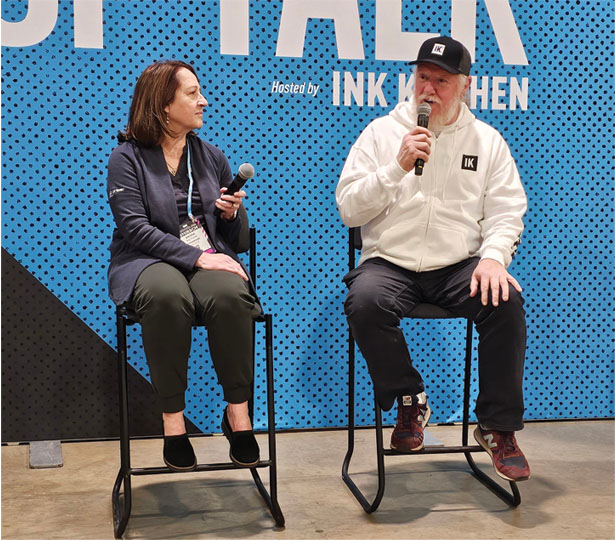Strategy March 26, 2024
Fit, Fabric & Garment-Construction Questions Answered
Andrea Routzahn of alphabroder shared her apparel expertise during a Shop Talk session at the Impressions Expo in Atlantic City.
When it comes to T-shirts, hoodies and other imprinted apparel, a lot of terminology gets thrown around – and it can be confusing for the average distributor or decorator. What’s the difference in feel between a 4.4-ounce tee and a 7-ounce shirt? Is combed ring-spun cotton really important? Why is it so hard to find clothing that fits the way you’d like? And just what does it mean when a garment is described as “30 singles”?

Andrea Routzahn of alphabroder (asi/34063) and Rick Roth of Mirror Image discuss apparel terminology and fashion trends at Impressions Expo in Atlantic City.
In a Shop Talk session from the Ink Kitchen at Impressions Expo Atlantic City last week, Andrea Routzahn, chief merchant at Top 40 supplier alphabroder (asi/34063), joined Rick Roth, an award-winning screen printer and president of Pawtucket, RI-based Mirror Image Inc., to discuss “Everything You Ever Wanted To Know About Garment Construction But Were Afraid To Ask.”
Here are some highlights from their conversation:
1
Fit & Size Aren’t the Same Thing
One of the biggest challenges for promotional products distributors and apparel decorators is figuring out sizing. “There’s a difference between the size number on the garment and the fit you like,” Routzahn said. “Everybody likes their clothes to fit differently.”
She gave the example of comedian Jerry Seinfeld, who’s stayed a pretty consistent size in the 30 or so years he’s been in the public eye. If you look at the polo shirts he wore in the ’90s, however, they had a dropped shoulder and long sleeve, Routzahn said, whereas today’s polos have shorter sleeves and a tighter fit. “They’re all a size large,” she added. “Fit changes over time, and preference changes over time.”
2
A Quick Primer on Fabric Terminology
Routzahn also discussed fabric weight, which is measured by ounces per square yard in the U.S. and grams per square meter in other parts of the world. Manufacturers use a system where they punch a certain number of circles in an area of fabric and then weigh them to uniformly identify fabric weight.
Fleece fabrics tend to be heavier weight – around 10 to 12 ounces – whereas T-shirts are lighter. The fashion T-shirts that were popular a few years ago were super-lightweight, around 4 to 4.5 ounces, while a heavyweight tee might be about 7 ounces.
Quality, when it comes to garments, can be as subjective as fit. “There are some folks who don’t really like a lightweight T-shirt,” she said. While it’s noticeably soft, “it’s a little clingy; it’s not very forgiving; it tends to wear out quickly.”
Fabric, she added, is only as strong as the yarn it’s woven from. “Combed ring-spun cotton yarn is just inherently stronger,” Routzahn said, adding that ring-spun comes from longer cotton fibers, and the longer the fibers as you twist them, the smoother the resulting yarn, which helps with hand feel as well as printability. “Open-end yarn” is made from shorter cotton fibers and spun in a different way.
Routzahn also explained that “singles” refers to how many sub-yarns are twisted into a yarn. Singles is a one-ply yarn, whereas doubles yarn, often used in fine shirting, is a two-ply yarn. The number at the beginning refers to the diameter of the yarn; the smaller the number, the fatter the yarn, so an 18 singles yarn is thicker than a 30 doubles.
3
What apparel trends should we be watching?
Trends are happening quicker than ever, Routzahn said. People used to say that if you’re old enough to have worn a trend the first time it came around, you shouldn’t wear it when it comes back, but “I think that’s changing,” she added. “It’s just so quick. It’s just going to spin and spin and spin.”
That speed has contributed to a personalization of style that goes beyond fad-chasing.
She did note that heavier-weight tees have become more popular than lightweight garments, and that color trends have shifted from ’80s-inspired neons to a slew of beige and ’70s earthtones. “If you want to see color trends, just walk through a Target,” Routzahn advised.
4
What does the future hold for the apparel industry?
Sustainability will continue to grow in importance for textiles, Routzahn said. “I think there’s going to be more and more of a return to natural fiber,” she added. “We’re all wearing mostly polyester, but polyester is made from oil; it’s made from chemicals. … I think there’s going to be a lot of interest in removing a lot of unnecessary chemicals from our fabrics.”
Recycled cotton has been gaining traction in the promo industry.
Hemp, Routzahn said, has a lot of potential and could be an interesting natural fiber for garments “if it can scale,” since it’s highly renewable and doesn’t require pesticides to grow.
She also brought up the idea of circularity and the importance of thinking about a garment’s end-of-life – not just its beginning. “That’s why quality is really important,” she said. “You want something that will last.”
